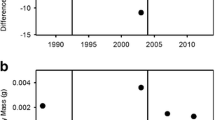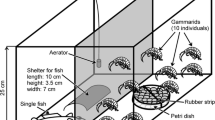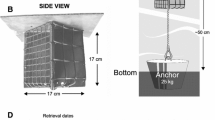Abstract
The introduction of zebra mussels (Dreissena spp.) to North America has resulted in dramatic changes to the complexity of benthic habitats. Changes in habitat complexity may have profound effects on predator-prey interactions in aquatic communities. Increased habitat complexity may affect prey and predator dynamics by reducing encounter rates and foraging success. Zebra mussels form thick contiguous colonies on both hard and soft substrates. While the colonization of substrata by zebra mussels has generally resulted in an increase in both the abundance and diversity of benthic invertebrate communities, it is not well known how these changes affect the foraging efficiencies of predators that prey on benthic invertebrates. We examined the effect of zebra mussels on the foraging success of four benthic predators with diverse prey-detection modalities that commonly forage in soft substrates: slimy sculpin (Cottus cognatus), brown bullhead (Ameirus nebulosus), log perch (Percina caprodes), and crayfish (Orconectes propinquus). We conducted laboratory experiments to assess the impact of zebra mussels on the foraging success of predators using a variety of prey species. We also examined habitat use by each predator over different time periods. Zebra mussel colonization of soft sediments significantly reduced the foraging efficiencies of all predators. However, the effect was dependent upon prey type. All four predators spent more time in zebra mussel habitat than in either gravel or bare sand. The overall effect of zebra mussels on benthic-feeding fishes is likely to involve a trade-off between the advantages of increased density of some prey types balanced against the reduction in foraging success resulting from potential refugia offered in the complex habitat created by zebra mussels.


Similar content being viewed by others
References
Beamish FWH, Noakes DLG, Rossiter A (1998) Feeding ecology of juvenile lake sturgeon, Acipenser fulvescens, in northern Ontario. Can Field Nat 112:59–468
Bially A, MacIsaac HJ (2000) Fouling mussels (Dreissena spp.) colonize soft sediments in Lake Erie and facilitate benthic invertebrates. Freshwater Biol 43:85–97
Botts PS, Patterson BA, Schloesser DW (1996) Zebra mussel effects on benthic invertebrates: Physical or biotic? J N Am Benth Soc 15:179–184
Briand F, Cohen JE (1987) Environmental correlates of food chain length. Science 283:956–960
Caraco NF, Cole JJ, Raymond PA, Strayer DL, Pace ML, Findlay SEG, Fischer DT (1997) Zebra mussel invasion in a large, turbid river: Phytoplankton response to increased grazing. Ecology 78:588–602
Caswell H (1978) Predator mediated coexistence: a non-equilibrium model. Am Nat 112:127- 154
Cobb SE, Watzin MC (2002) Zebra mussel colonies and yellow perch foraging: spatial complexity, refuges, and resource enhancement. J Great Lakes Res 28:256–263
Crowder LB, Cooper WE (1982) Habitat structural complexity and the interaction between bluegills and their prey. Ecology 65:1802–1813
Deihl S (1992) Fish predation and benthic community structure: the role of omnivory and habitat complexity. Ecology 73:1646–1661
Dudgeon D (1996) The influence of refugia on predation impacts in a Hong Kong stream. Arch Hydrobiol 138:145–159
Eadie JM, Keast A (1984) Resource heterogeneity and fish species diversity in lakes. Can J Zool 62:1689–1695
Eklöv P (1997) Effects of habitat complexity and prey abundance on the spatial and temporal distributions of perch (Perca fluviatilis) and pike (Esox lucius). Can J Fish Aquat Sci 54:1520–1531
Eklöv P, Diehl S (1994) Piscivore efficiency and refuging prey: the importance of predator search mode. Oecologia 98:344–353
Gilinski E (1984) The role of fish predation and spatial heterogeneity in determining benthic community structure. Ecology 65:455–468
Glass NR (1971) Computer analysis of predation energetics in the largemouth bass. In: Patten BC (ed) Systems analysis and simulation in ecology, vol 1. Academic, New York, pp 325–363
González MJ, Downing A (1999) Mechanisms underlying amphipod responses to zebra mussel (Dreissena polymorpha) invasion and implications for fish-amphipod interactions. Can J Fish Aquat Sci 56:679–685
Gotceitas V, Colgan P (1989) Predator foraging success and habitat complexity: quantitative test of the threshold hypothesis. Oecologia 80:158–166
Holt RD (1984) Spatial heterogeneity, indirect interactions and the coexistence of prey species. Am Nat 124:377–406
Huffaker CB (1958) Experimental studies on predation: dispersion factors and predator-prey oscillations. Hilgardia 27:343–383
Jack JD, Thorp JH (2000) Effects of the benthic suspension feeder Dreissena polymorpha on zooplankton in a large river. Freshwater Biol 44:569–579
Kolar CS, Fullerton AH, Martin KM, Lamberti GA (2002) Interactions among zebra mussel shells, invertebrate prey, and Eurasian ruffe or yellow perch. J Great Lakes Res 28:664–673
Lombardo P (1997) Predation by Enallagmanymphs (Odonata, Zygoptera) under different conditions of spatial heterogeneity. Hydrobiologia 356:1–9
Mayer CM, Rudstam LG, Mills EL, Cardiff SG, Bloom CA (2001) Zebra mussels (Dreissena polymorpha), habitat alteration, and yellow perch (Perca flavescens) foraging: system-wide effects and behavioural mechanisms. Can J Fish Aquat Sci 58:2459–2467
McNair JN (1986) The effects of prey refuges on predator-prey interactions: a reconsideration. Theor Popul Biol 29:38–63
Mellina E, Rasmussen JB, Mills EL (1995) Impact of mussel (Dreissena polymorpha) on phosphorus cycling and chlorophyll in lakes. Can J Fish Aquat Sci 52:2553–2573
Mittelbach GG (1988) Competition among refuging sunfishes and effects of fish density on littoral zone invertebrates. Ecology 69:614–623
Murdoch WW, Oaten A (1975) Predation and population stability. Adv Ecol Res 9:1–131
Persson L, Eklöv P (1995) Prey refuges affecting interactions between piscivorous perch (Perca fluviatilis) and juvenile perch and roach (Rutilus rutilus). Ecology 76:70–81
Ricciardi A, Whoriskey FG, Rasmussen JB (1997) The role of the zebra mussel (Dreissena polymorpha) in structuring macroinvertebrate communities on hard substrata. Can J Fish Aquat Sci 54:2596–2608
Ritchie BJ, Colby PJ (1988) Even-odd year differences in walleye year-class strength related to mayfly production. N Am J Fish Manage 8(2):210–215
Savino JF, Stein RA (1982) predator-prey interaction between largemouth bass and bluegills as influenced by simulated submersed vegetation. Trans Am Fish Soc 111:255–266
Savino JF, Stein RA (1989) Behavior of fish predators and their prey: habitat choice between open water and dense vegetation. Environ Biol Fish 24:287–293
Scott WB, Crossman EJ (1973) Freshwater fishes of Canada. Bull Fish Res Bd Can 184:966
Stein RA (1977) Selective predation, optimal foraging, and the predator-prey interaction between fish and crayfish. Ecology 58:1237–1253
Stewart TW, Miner JG, Lowe RL (1998) Quantifying mechanisms for zebra mussel effects on benthic macroinvertebrates: organic matter production and shell generated habitat. J North Am Benth Soc 17:81–94
Stoner AW (1982) The influence of benthic macrophytes on the foraging behavior of pinfish, Lagodon rhomboides. J Exp Mar Biol Ecol 58:271–284
Taylor RJ (1984) Predation. Chapman and Hall, London
Vince SU, Valiela, Backus N, Teal JN (1976) Predation by the salt marsh killifish Fundulus heteroclitus in relation to prey size and habitat structure: consequences for prey distribution and abundance. J Exp Mar Biol Ecol 23:255–266
Ware DM (1973) Risk of epibenthic prey to predation by rainbow trout (Salmo gairdneri). J Fish Res Bd Can 30:787–797
Werner EE, Hall DJ (1988) Ontogenetic habitat shifts in bluegill: the foraging rate-predation risk trade-off. Ecology 69:1352–1366
Werner EE, Hall DJ, Laughlin DR, Wagner DR, Wilsmann LA, Funk FC (1977) Habitat partitioning in a freshwater fish community. J Fish Res Bd Can 34:360–370
Whitehead H, Walde SJ (1992) Habitat dimensionality and mean search distances of top predators: implications for ecosystem structure. Theor Popul Biol 42:1–9
Wu L, Culver DA (1992) Ontogenetic diet shift in Lake Erie age-O yellow perch (Perca flavescens): a size-related response to zooplankton density. Can J Fish Aquat Sci 49:1932–1937
Acknowledgements
We would like to thank Ryan Dubois, Kathleen Coons, Anna Mazloff, Kevin Rice, Eric Carlson, and Aimee Ahari for their help conducting the laboratory experiments, and Douglas Glazier for providing amphipods. This project was funded by an EPSCoR grant from the University of Vermont and by National Sea Grant. Additional funds and materials were provided by St. Michael’s College and the Vermont Genetics Network. All experiments conducted during this study conform to laws regarding animal care in the United States.
Author information
Authors and Affiliations
Corresponding author
Rights and permissions
About this article
Cite this article
Beekey, M.A., McCabe, D.J. & Marsden, J.E. Zebra mussels affect benthic predator foraging success and habitat choice on soft sediments. Oecologia 141, 164–170 (2004). https://doi.org/10.1007/s00442-004-1632-1
Received:
Accepted:
Published:
Issue Date:
DOI: https://doi.org/10.1007/s00442-004-1632-1




